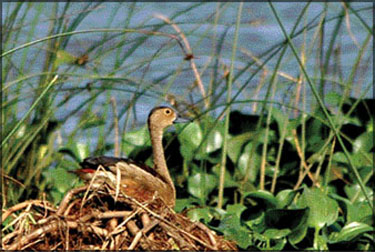Wetlands of Sri Lanka
By Aravinda DASSANAYAKE
A wetland is generally an area which has soil that is saturated
(filled) with moisture, such as a swamp or marsh. You must have read our
article on wetlands some time back.
 |
Bundala lagoon
|
It is noteworthy to mention that Sri Lanka has a geography which
supports the formation of wetlands to a great extent. Due to diverse
geographical settings, wetlands of different areas display different
characteristics.
Until quite recently, the importance of wetlands was not identified
in Sri Lanka. Most of the time, they were drained and used as
construction space and for garbage dumps.
However, the significance these wetlands have in the eco-system of
the environment has now been identified. Therefore, in today’s article
let’s look at the different types of wetlands in our country and their
different uses.
The wetlands that are found in the country could be divided into
three categories as follows;
1. Inland natural freshwater wetlands
2. Marine and salt water wetlands
3. Man-made wetlands
Inland natural freshwater wetlands
These are the wetlands that are formed by internal waterways such as
rivers, lakes, natural reservoirs and marshes. Within this category,
there are a few sub-categories. One type contains all the streams and
rivers which in total account for about 4,500 kilometres of waterways.
There is also a category known as ‘Villu’ wetlands. These are quite
large lakes which are floodplain lakes that could be seen on river
bends. These are prominent in the Mahaweli floodplain in the East of the
country.
Freshwater marshes also come under this category; they are shallow
depressions (sunken areas) that get fed by river floodwater or
groundwater seepage. The Muthurajawela Marsh is a classic example of
such a freshwater marsh.
Another type called ‘freshwater swamp forests’, which is in fact a
later stage of the freshwater marshes, are also found. In this stage,
certain trees adapt to thrive in the shallow stagnant water of the
marsh.
The Walauwa-Watta Wathurana Swamp Forest, located in the Kalu Ganga
basin, is a good example of this type and it is said that freshwater
swamp forests are the rarest type of wetlands in the country.
Marine and salt water wetlands
Simply put, these are wetlands that are found in the coastal areas of
the country where a mixture of freshwater and salt water, resulting from
tidal fluctuations, exists within the wetland.
 |
Maduganga estuary
|
Such wetlands could be found in estuaries where rivers flow in to the
sea.
There is a special variation of these wetlands called mangroves which
contain diverse plant communities like in freshwater swamp forests.
Typical examples of estuaries with mangrove wetlands in Sri Lanka are
the Maduganga estuary, Bentota estuary and Kalaoya estuary.
Lagoons such as Bundala Lagoon, Mundel Lake and Kalametiya Lagoon
also come under this category and these could also contain mangrove
formations. Salt wetlands are found in coral reefs which generally
reside below six metres in depth.
These are found in the Gulf of Mannar region, Trincomalee to Kalmunai
in the east coast and in several areas of the south and south-western
coast, including Rumassala and Hikkaduwa. A unique type of salt wetland
is found in the Wilpattu National Park, which is an inland wetland
containing salt water.
Man-made wetlands
These are wetlands that had been created by humans ever since the
beginning of civilization in the country.
The primary man-made wetlands are reservoirs or ‘wewas’ and it is
noteworthy to mention that Sri Lanka probably has the highest number of
man-made water bodies in the world with an estimated total of more than
10,000 ‘wewas’ countrywide. In addition, the wetlands created for
aquaculture and agriculture also fall under this category.
How are they useful?
The interaction between soil, water, plants and animals in the
wetlands enable many functions which are useful to people as well as the
entire eco-system. In addition, these perform a range of functions which
are extremely important.
Where uses are concerned, wetlands become useful in applications
related to water supply, medicinal herbs, salt, agriculture and tourism.
Important herbs such as ‘Lunuwarana’ and ‘Neeramulliya’ are taken from
marshes.
 |
Muthurajawela marsh
|
In addition, a range of raw materials such as ‘Kaduru’ and Pandanus
leaves, which are necessary for traditional crafts, are also extracted
from marshes and mangroves. The Hambantota lagoon is the main provider
of salt and in addition, areas like the Bundala wetland are popular for
tourism and recreation.
Where functions are concerned, marshes play a vital role in the
mitigation (reducing) of floods, purification of water and as a carbon
sink where carbon dioxide is accumulated.
Tanks also help to mitigate floods. Mangroves, marshes and sea-grass
beds become extremely important in the eco-system as breeding habitats
for a wide variety of fish. Mangroves and coral reefs provide protection
from storms and erosion.
The biodiversity of wetlands, which supports a range of animal and
plant species, is very significant.
For example, among the total inland species with backbones in Sri
Lanka, about 30 per cent are ecologically dependent on wetlands. Among
the migratory birds that visit Sri Lanka annually, more than 50 per cent
are directly dependent on wetlands for food and shelter. |
